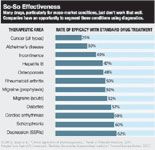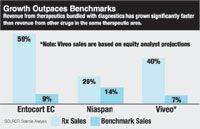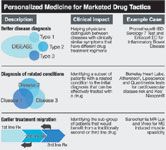Overlooked Opportunities
"Test and treat" strategies aren't just for new-to-market drugs anymore.
If you look at pharma's pipeline, you'll see that personalized medicine is powering drug development. Every major pharma company has a biomarker development program to bring new targeted therapies to market. But there's also an opportunity for companies to apply the paradigm of personalized drugs—specifically, the use of diagnostics to "test and treat"—to therapies already on the market. Companies can leverage diagnostics to drive sales by identifying patients who respond to a given therapy. Industry can best apply this tactic to smaller revenue drugs, where traditional techniques are either ineffective or don't offer a good return on investment.
For pharma companies facing a difficult economic climate, pairing diagnostics with therapies offers a powerful incentive: Manufacturers can improve sales by helping physicians find the most appropriate therapeutic option. One of the key benefits of this approach is that the molecule remains unchanged; rather, the patient base is selected to maximize benefit—which is less expensive than conducting additional clinical trials for new and improved molecules.
There is an opportunity to apply a more personalized approach to small-molecule drugs because many are not effective across the general populations they purport to help. (See "So-So Effectiveness".) Still, within these uninspiring numbers, there are subgroups of patients that do respond to treatment. Companies that launch a diagnostic test can identify these subgroups of "responders," build relationships with doctors by providing them a tool that dictates effective treatment and spares patients adverse events, and argue the value of the drug to payers.

Yet pharmaceutical companies have ignored the opportunity to utilize the same biomarkers and resulting diagnostics for marketed drugs because of one key difference: There isn't a one-to-one correlation. Rather, diagnostics for marketed drugs identify patients that respond to a class of drugs, not a specific drug. That means class leaders have the potential to gain the greatest value from linkage to a diagnostic test. But other drugs that offer differentiated benefits can also generate returns.
How does this work? The linkage to a diagnostic changes the discussion inside the physician's office. Instead of just pitching a drug, reps can speak with doctors about particular patient populations; early disease detection, diagnosis, and differentiation of patient subsegments; selecting pharmaceuticals and avoiding therapeutic side effects; and therapy monitoring. Reports from companies pioneering this effort indicate easier physician access and longer sales calls than traditional therapeutic-only pitches—and an incredible increase in sales. (See "Growth Outpaces Benchmarks".)

Here, we offer several case studies from specialty pharmaceutical companies that illuminate best practices and demonstrate the viability of this new approach in both the US and Europe.
Better Disease Diagnosis
Disease areas in which physicians struggle to make a differential diagnosis are ideal for the introduction of diagnostics. Irritable bowel syndrome (IBD) is a good example. Patients with IBD usually present to physicians with pain, cramping, and diarrhea. Distinguishing between IBD and other gastrointestinal disorders usually requires invasive and expensive procedures, such as colonoscopies, endoscopies, and CT and MRI scans. And once an IBD diagnosis is made, physicians still need to distinguish between the two major forms—Crohn's disease and ulcerative colitis—to determine treatment.
Into this market came Entocort EC (budesonide), developed by AstraZeneca and launched in the US in 2001 for the treatment of mild to moderate Crohn's disease. Entocort EC is an enteric-coated formulation of the well-known steroid, designed to release the drug in the colon and generate lower systemic absorption with fewer side effects. But by 2003, sales of the drug were only $25 million—leading AstraZeneca to outlicense it to Prometheus Labs, a San Diego-based specialty pharma.

Given the difficulty in making diagnosis and treatment decisions, the benefits of a diagnostic test were obvious. Prometheus developed one (which in its updated version, IBD Serology 7, had 92 percent reported accuracy) to help physicians distinguish subtypes of IBD based on serology markers found in the blood, as well as determine the severity of the disease.
Prometheus Labs recruited a 170-person specialty sales force to market the diagnostic as well as Entocort EC and other proprietary pharmaceuticals. In doing so, Prometheus was able to help physicians identify a subset of patients who would benefit from the therapeutic agent, and improve the efficacy of Entocort EC without chemically altering the drug. With the promise of improved efficacy highlighted by the diagnostic, Prometheus was able to immediately raise the average wholesale price for Entocort EC by 66 percent upon acquiring the rights in 2005, and 10 percent every year thereafter. The current pricing for Entocort EC is 120 percent of the price when Prometheus started marketing it, reflecting the increased value to patients, physicians, and payers
Prometheus' ability to work in both the diagnostic and therapeutic areas was critical to achieving a quintupling of sales. Entocort EC sales in the US have grown by 59 percent annually since Prometheus started detailing the drug—and are now $125M annually.
The value of this approach becomes even more apparent when compared with the European market, where AstraZeneca retained ownership but attempted to boost sales through traditional models. In Germany, AZ negotiated an exclusive promotion agreement with Eisai GmbH to market Entocort EC. But without a diagnostic, Entocort EC sales grew only 10 percent annually from 2005 to 2007, and just 7 percent in constant dollars.
The IBD Serology 7 test marketed by Prometheus helped identify patients with Crohn's disease; it did not point physicians to prescribing Entocort EC. In keeping with the American College of Gastroenterology guidelines, physicians could prescribe an oral steroid for patients with mild to moderate Crohn's disease—a category in which Entocort EC is the major branded product. The diagnostic also helped identify ulcerative colitis patients, who would not benefit from Entocort EC.
Diagnosis of Related Condition
Diagnostics are also helpful in identifying new patient populations that can benefit from available treatments. Niaspan, an extended-release formulation of niacin launched by Kos Pharmaceuticals (now Abbott) in 1997, offers one example of how to maneuver in this area.
Niaspan treats hypercholesterolemia, and is indicated as an adjunct to diet and statin medications. When taken in large doses, the drug blocks the breakdown of fats in adipose tissue, specifically very low density lipoprotein (VLDL), the precursor of LDL or "bad" cholesterol, and increases the level of high density lipoprotein (HDL) or "good" cholesterol in blood.
The traditional routine cholesterol panel (total cholesterol, HDL, and LDL) provides only a 40 percent predictive value for coronary heart disease. But in 2003, several diagnostic companies launched a new test—an LDL subfractionization test—that identifies more than 90 percent of patients at risk for heart disease. The tests identified at-risk patients with normal LDL test results (that is, patients who would otherwise not be diagnosed) and identified a subset of patients who would benefit from a combination of drugs to boost HDL levels using Niaspan instead of statins alone.
Although there were many drugs physicians could choose from, based on Kos' marketing effort, Niaspan achieved US sales of approximately $225 million by 2003, growing at a 26 percent pace compared to 14 percent growth for statins, the standard of care for patients with high cholesterol.
Earlier Treatment Migration
Prescription by trial-and-error, particularly when it comes to more serious conditions, is an unacceptable approach to treatment. However, in multiple sclerosis, that was the standard of patient care for far too long.
The symptoms of MS mimic many other neurological disorders and may disappear and recur periodically. Physicians diagnose MS mostly by ruling out other conditions, and then conducting tests of visual-evoked response and brainstem auditory-evoked response, followed by a brain MRI to confirm diagnosis. As the degenerative nature of the disease takes its toll over time, second and third line treatments are used until they are no longer efficacious.
An Austrian company, Sanochemia AG, saw a market opportunity to improve MS diagnosis and improve uptake of Viveo (tolperisone), an immediate-release muscle relaxant used to treat painful muscle cramps and spasticity associated with neurological conditions. Tolperisone is a third line treatment that was originally launched in Europe by Orion Pharmaceuticals at the end of 2007. Viveo is a more potent form of tolperisone, which is available as a generic in Germany, and was launched at a 20 percent price premium. Orion detailed the drug with a 130-person, neurology-focused sales force. In March 2008, Sanochemia launched MR-Lux, an MRI contrast agent (gadopentate dimeglumine) used to diagnose MS and other CNS conditions.
With this diagnostic on the market, neurologists were able to make a definitive diagnosis of MS, which in turn meant that patients migrated to Viveo more quickly. Since launch, Viveo has doubled initial expected sales and is projected to grow at 40 percent compared to 7 percent projected increase in sales of generic tolperisone. The ability of Viveo to leapfrog less expensive generic tolperisone is due to its improved dosing, which leads to better patient compliance. The chronic and degenerative nature of MS puts a premium on simplifying the therapeutic regimen for a patient.
Other diseases that follow this pattern present an opportunity for linking diagnostics with therapeutics. These examples vary by therapeutic area, geography, and developer—but there are also striking similarities. First, the marketed drugs are not targeted therapies that work against a specific biomarker or unique disease pathway. Rather, they are small-molecule drugs whose mechanism of action is not unique. In each case, the drugs are reformulations of compounds with generic competitors available. Second, the diagnostic was brought to market after the drug was launched, often by a third party with no special knowledge of clinical results from drug development.
Because the biomarkers used for the bundled diagnostic are not exclusive to the drug developer, there is an opportunity for late-to-market participants to effectively compete using this approach. In fact, the basic science that underpins the biomarkers was either developed by academic research institutions and licensed by diagnostic developers, such as the case with Prometheus and Berkeley Heart Lab, or had been on the market for some time, as was the case with Sanochemia Diagnostics.
Given that the diagnostic test only identifies the class of drugs that are effective for a group of patients, sales presence does matter. The sales force must be able to answer questions about the diagnostic and clinical guidelines for disease treatment. There cannot be a single-minded pursuit of sales of a particular drug, because the diagnostic will also highlight patient subgroups that will not respond appropriately.
Where It Works
Forty percent of US branded pharmaceutical sales are derived from products that sell less than $150 million annually. Despite their importance to the industry, growing these products has proven difficult. The techniques and strategies that are effective for larger sales compounds, such as reformulation and indication expansion, can rarely be justified for smaller products. What's more, there's little ROI for these small drugs in tapping the usual media mix. Instead, these compounds gain attention only when a generic drug launches a patent challenge—or the company decides the drug no longer fits within its strategic priorities, and sells it off.
While the personalized medicine approach does work with larger volume sales products, it must compete with more traditional life cycle management techniques, which may generate similar or better returns. AstraMerck's decision to acquire the marketing rights to a hand-held diagnostic gastric ulcer test (HPChek, in 1996) offers an example. At that time, Prilosec was the leading proton pump inhibitor, with annual US sales approaching $2 billion. AstraMerck obtained an indication expansion for Prilosec for the treatment of gastric ulcers in combination with the antibiotic Biaxin. The test developed by the now-defunct Chemtrak was an inexpensive ($12), disposable, single-use, whole-blood test that provided confirmation of H. pylori antibodies as an alternative to endoscopy and biopsy. HPChek received FDA approval in 1996.
Upon approval, AstraMerck obtained full marketing and distribution rights for HPChek, and the test was marketed along with Prilosec. Results from this marketing demonstrated a healthy 18 percent growth in sales of Prilosec to treat gastric ulcers. AstraMerck, however, concurrently launched an extensive direct-to-consumer marketing campaign for Prilosec, emphasizing the main indication of gastroesophageal reflux disease, which grew sales by 32 percent during the same time period. Based on these results, AstraMerck returned the rights to HPChek to Chemtrak after five quarters.
First Mover Advantage
The first-mover diagnostic that helps identify and segment patients by disease can potentially affect multiple drugs in a class. After an initial diagnostic is available in a particular disease area, roadblocks appear. For the drug developer that starts to see sales of traditionally stable products decline, there may be insufficient time to mount a competitive response.
The second mover who attempts to leverage a diagnostic test will need to launch a differentiated test that provides additional medically relevant disease information. Given the nature of the small-molecule drugs that do not exclusively bind to a single target, this can present an expensive technical hurdle.
The explosive growth in diagnostics based on advancements in molecular medicine will drive more opportunities for this approach. In many cases, the diagnostic will already be FDA approved, and the challenge will be integrating the product, diagnostic, sales, marketing, and reimbursement capabilities. In other instances, the diagnostic will need additional development and clinical validation. Nevertheless, the additional costs for these activities will be less than the costs of manipulating the molecule or paying for clinical trials to expand indications.
The source of this innovation will not necessarily be the original drug developers. Academic researchers, diagnostic companies, clinical labs, and specialty companies will also play a critical role in providing content. Pharma companies that need to extract the maximum value from their current portfolios will also play a role. While pharmaceutical companies that have diagnostic divisions may have an initial advantage over "pure plays," the availability of strong diagnostic sales and marketing capabilities at clinical labs and independent diagnostic developers will provide strategic and alliance opportunities for pharmas to take advantage of.
Amit Agarwal is a partner with Scientia Advisors. He can be reached at aagarwal@scientiaadv.com
The Misinformation Maze: Navigating Public Health in the Digital Age
March 11th 2025Jennifer Butler, chief commercial officer of Pleio, discusses misinformation's threat to public health, where patients are turning for trustworthy health information, the industry's pivot to peer-to-patient strategies to educate patients, and more.
Navigating Distrust: Pharma in the Age of Social Media
February 18th 2025Ian Baer, Founder and CEO of Sooth, discusses how the growing distrust in social media will impact industry marketing strategies and the relationships between pharmaceutical companies and the patients they aim to serve. He also explains dark social, how to combat misinformation, closing the trust gap, and more.
